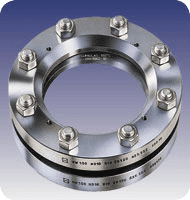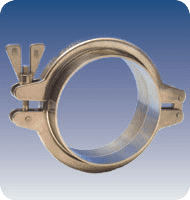Will My Sight Glass Corrode?
Posted on October 30, 2019 by LJ Star
While inherently resistant to corrosion, sight glasses can begin to corrode under the right circumstances, particularly if the wrong material is spec’d for the application. If a sight glass happens to corrode, it becomes increasingly vulnerable to sight glass failure. When glass fails, it is often sudden and catastrophic, damaging your system, putting workers at risk, and causing unplanned downtime. That’s why it’s important to understand the dangers of sight glass corrosion and failure so that you can adequately prepare for them… and avoid a costly disaster.
Also referred to as a sight window or a sight port, a sight glass allows for the convenient, safe, and non-intrusive observation of a closed system’s interior. A sight glass that is properly installed and spec’d to your unique application can be incredibly resistant to extreme temperatures, pressure fluctuations, and even corrosion. However, certain conditions put sight glasses at an extra risk for corrosion and overall damage. These include:
- Contact with aggressive chemicals like hydrofluoric acid, concentrated phosphoric acid, and hot concentrated alkali solutions
- Contact with superheated water
- Improper or abrasive cleaning
- Continual contact with coarse process media
- Rapidly rising/falling temperatures (thermal shock)
- Over-pressurization
Apart from these dangers, your sight glass faces an increased risk of failure or corrosion if it is improperly installed, mishandled during operation, or designed poorly (or for the wrong application). Glass removed from service should never be reused, so trying to use an old sight glass for a new operation can also lead to problems. Even if an old sight glass was barely used, the stressing and destressing that the glass goes through during installation can cause tiny, microscopic faults in the material. While you typically won’t be able to see these tiny cracks through a visual inspection, they can weaken the structural integrity of the glass, leaving it vulnerable to a break.
The viscous cycle involving sight glass corrosion and breaks is that each can be a precursor for the other. A corroding glass will be more suspectable to breaks and fractures while a crack can ruin the integrity of a glass, leaving it open to corrosion.
If any of these types of damage leads to failure, the result can be rather disastrous… even fatal. A failed sight glass can easily damage your system and leave it open to the surrounding environment, putting your equipment out of commission and ruining any product or materials that were inside them. Glass can crack at five miles per second, ejecting thick chunks and glass shards at speeds significantly faster than the quickest fighter jets. In just three recent incidents, two of which involved chemical processing facilities and one that occurred at a pharmaceutical plant, sight glass failures caused more than $68 million in damages and downtime. The worst part certainly was that among these incidents, nearly 30 people lost their lives.
How to Avoid Sight Glass Corrosion and Failure
Proper sight glass selection, installation, and maintenance are all necessary if you want to avoid the dangers of a sight glass failure. This starts with the selection of the glass itself.
There are many different types of glass that you can choose from. Soda lime glass is often used, but it has critical limitations in terms of temperature and pressure specifications; tempered soda lime should not be used in applications above 300°F.
Borosilicate glass is often the go-to choice for chemical, biotech, and pharmaceutical processing due to its remarkable chemical and mechanical specifications. These include:
- Temperature capabilities to 572 °F
- Broad-spectrum corrosion resistance
- Low thermal expansion
- Excellent transparency and visibility
For applications above 572°F, process engineers turn to quartz and sapphire material.
The chemical degradation or corrosion of soda lime glass occurs much more quickly beginning both at slightly acidic conditions, when pH levels equal 6, and at alkaline conditions at pH levels equal to 10. Soda lime degradation is 10 times greater than borosilicate glass.
For further details regarding the physical characteristics of Borosilicate glass, ASTM E438 “Standard Specification for Glasses used in Laboratory Apparatus” is available as a reference material. Another standard to refer to is DIN 7079, which stipulates whether the sight glass can withstand high temperatures, high pressure and corrosive chemicals.
In addition to the above, borosilicate glass is also well known for its mechanical strength. Its compression strength is excellent, around 200 thousand pounds per square inch, with a tensile strength more than 10x that of steel.
Choosing the increasingly popular option of mechanically prestressed glass can also help you to avoid many of the ways that sight glasses fail when compared with standard windows.
A mechanically prestressed sight glass consists of a stainless-steel ring encompassing a disc of borosilicate glass. The key to this sight glass’s success is that the steel ring applies a uniform radial compression to the glass itself. This radial compression improves the performance of the glass by preventing tensile stress from affecting the glass. This means a sight glass that will withstand harder impacts and greater stress forces.
Once you pick the right design for your operation, you’ll want to make sure that the glass is thick enough for your application. Glass failure can occur if the internal pressure of the glass exceeds its maximum pressure capability.
Corrosion of course is also a factor with the metal ring used in a sight glass window. Most system designers know which type of stainless steel must be used in order to handle their caustic or acidic process medium, and they will specify this steel to their sight glass supplier. In some cases, a sight glass may be mounted in such a way that the metal ring does not come in contact with the process fluid, and therefore lower cost steel may be used.
Whether it’s initial installation or continual maintenance, on the sight glass itself or your system as a whole, you’ll need to make sure that anyone working on or near the sight glass has been properly trained for best practices. The flat surface of a sight glass can be a tempting place to set a tool down for an untrained maintenance worker. Even a tiny bang from a wrench or a scratch from the abrasive material on a gloved hand can weaken the glass. Harsh cleaning agents can also wreak havoc, leading to untimely corrosion.
Once installed, it’s simple – the less contact that you have with your sight glass, the better.
Learn more by watching our webcast on sight glass selection and maintenance.
Watch the Webinar
Subscribe to our Blog
Categories
- Certifications
- Company
- In The News
- Industry Information
- METAGLAS® Sight Glasses
- PackExpo 2020
- Sanitary Clamps
- Sanitary Fittings
- Sight Flow Indicator Benefits
- Sight Glass Applications
- Sight Glass Construction
- Sight Glass Lighting
- Sight Glass Lights
- Sight Glass Process Vessel Camera
- Sight Glasses
- Trade Shows
- Webcast


